Things You Must Know about Porsche's 911 GTS T-Hybrid Powertrain
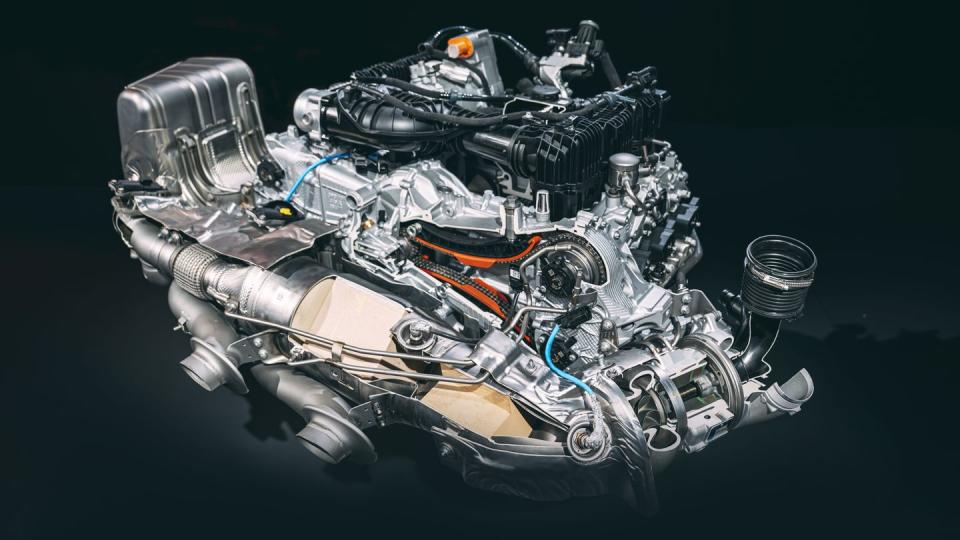
"T-Hybrid" is the moniker Porsche has given to the performance hybrid powertrain that energizes the new 2025 992.2 911 Carrera GTS. The T stands for Turbo and means performance. That, not fuel economy, is the focus of this new configuration.
And it represents a complete overhaul of the 911 engine that debuted with the 991.2 models for the 2017 model year. Instead of the 3.0-liter twin-turbocharged 9A2B6 used on the 992.1, the 992.2 GTS gets an 9A3B6 engine that displaces 3.6 liters, uses a single, electrically enhanced turbocharger, and is supplemented by a powerful electric motor/generator that shares the housing of the eight-speed PDK transmission—all operating on a 400-volt electrical system.

All-New Engine That’s Both Bigger and Smaller
The 9A3B6 (shown at top) grows in displacement from 2981 to 3591 cc, thanks to the bore and stroke increasing from 91.0 x 76.4 to 97.0 x 81.0 mm. But it also takes up less space, shrinking from top to bottom by 4.3 inches to make room for the hybrid systems' power control electronics between the top of the engine and the 911's classic sloping engine cover. The oil filter has been moved from the top to the bottom of the engine to maintain accessibility.
Not only is the new engine's intake manifold less bulky, but so are the redesigned cylinder heads. The valvetrain now employs finger followers with less friction than the previous bucket tappets. This change eliminated the older engine's VarioCam Plus variable valve lift, which is no longer deemed necessary to broaden the torque curve. These heads also have larger intake and exhaust ports to accommodate greater throughput through the engine.
Shaving the size of the crankshaft counterweights saved a little over four pounds of weight without affecting smoothness. Other changes, such as the elimination of the accessory drive, reduced overall as-installed engine weight by about 40 pounds to 459 pounds.
Lambda 1 and Its Penalties
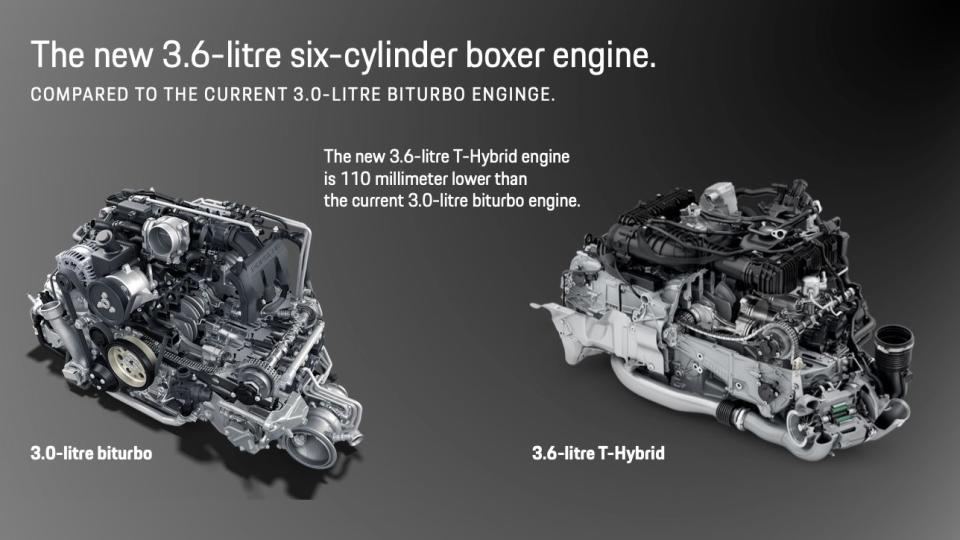
Compared with the 9A2 engine in the 992.1 GTS. the 9A3 engine's compression ratio has increased 10.2:1 to 10.5:1, and peak boost pressure rises from 18.6 to 26.1 psi. Ordinarily, these changes, and the displacement increase, would suggest a power increase from 473 in the old engine to roughly 700 ponies in the new one. After all, that's nearly as much displacement and vastly more boost than today's 640-hp 911 Turbo S.
In fact, the power only increases by 5 horsepower, to 478, while peak torque rises not at all from 420 pound-feet. The culprit is Lambda 1—meaning a perfectly balanced ratio of fuel and air at all engine operating points. For decades, all modern engines have operated at an air-to-fuel ratio of Lambda 1 because that produces the only exhaust that can be used by three-way catalysts to reduce all three of the major smog pollutants. Only at full throttle, which rarely occurs during the emissions tests, have engines gone slightly rich to increase power by perhaps 2 percent, to reduce temperatures to preserve engine or catalyst longevity, or to suppress detonation in turbocharged engines.

By eliminating the possibility of using a rich mixture (up to 8 percent rich on the 992.1 GTS) during boosted operation, peak combustion-chamber temperatures rise to a point where ignition timing must be dramatically retarded to control detonation. That reduces power substantially. Adding boost makes up for some of this loss, but higher boost also produces higher intake temperatures, and that's also counterproductive. To offset this somewhat, the 9A3 engine gets a single intercooler rather than the two smaller ones on the previous engine. This approach offers more surface air to better cool the intake charge.
So why did they do the Lambda 1 business? Apparently, there's a Motor Authority regulation in place in Germany that has required Lambda 1 under all operating conditions. There are exceptions for certain high-performance engines where the power enrichment could be justified. But with the 9A3 engine, Porsche has decided to comply. So we end up with a larger engine and more boost that produces hardly more output, but operates more cleanly, even at full power. We can see a great opportunity for the engine tuning community here, once they figure out how to enrich the mixture and advance the spark timing on this engine.
A Single Electric Turbocharger
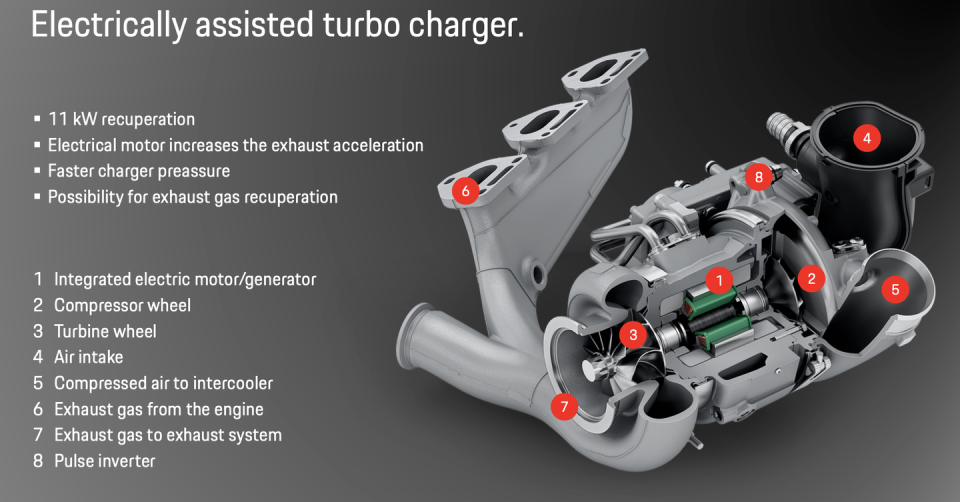
Instead of the 992.1 GTS's twin turbos, the new model gets a single blower with a 20-kW (27-hp) motor mounted between the compressor and exhaust sides of the turbo, with roller bearings on each end of the motor. The rotational energy provided by this motor greatly reduces turbo lag at low rpm. For example, at 2000 rpm and a closed throttle, the old GTS required more than three seconds to achieve full boost when the throttle was floored, while the new GTS does it in slightly less than one second—and that's to achieve considerably higher boost pressure.
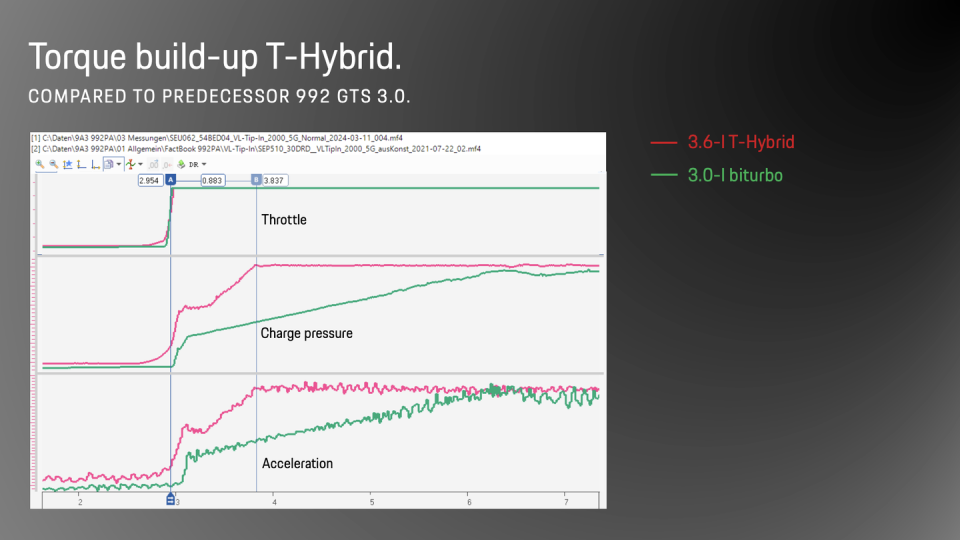
This new electric turbo—made by BorgWarner, as were the old units—is considerably larger than the old pair. The previous GTS (and S and 992.2 base) units measured 2.2 inches (55 mm) in diameter on the compressor side and 1.9 (8 mm) on the exhaust. The new one measures 3.3 and 3.1 inches (83 mm and 80 mm) respectively, commensurate with the much larger volume of air it must move.
There is no waste gate on the unit. Instead, at high rpm, the motor turns into a generator and produces up to 15 horsepower. That draws enough power from the turbine to prevent the turbo from exceeding its 125,000-rpm redline. The electricity produced goes to the battery, if needed—and to the electric motor, and supplements total power from about 5700 rpm on up at full throttle.
Asymmetric Exhaust System
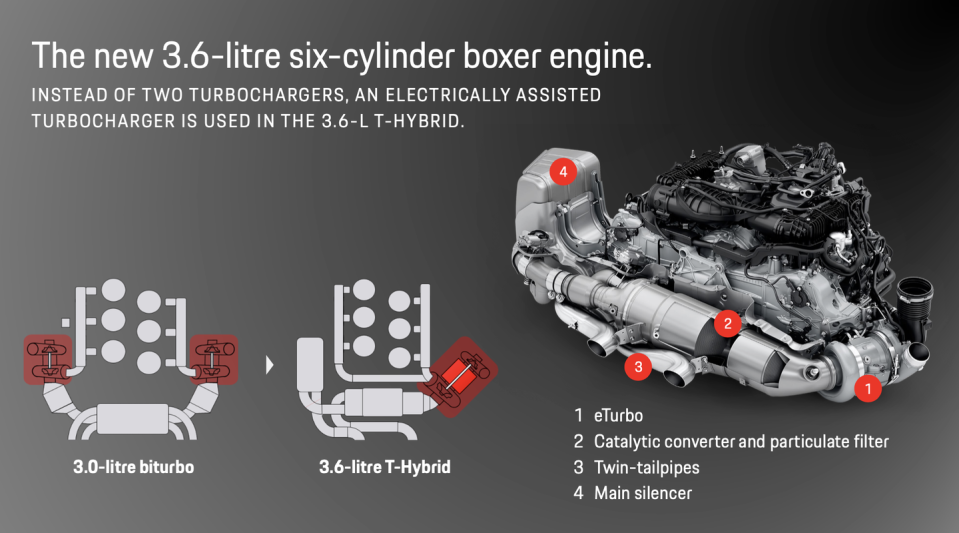
This single large electric turbo is larger than each of the old twin turbos, which were placed on either side of the engine. So Porsche engineers positioned the big turbo on the engine's right and used a crossover manifold from the engine's left bank of cylinders to feed exhaust gas to the turbo. The Turbo and its manifolding together weigh about 60 pounds, which is the same as the old twin-turbos weighed with their manifolds.
With the turbo on the right, the engine's muffler was tucked into the space on the left side. It looks more like a small fuel tank than the usual cylindrical shape of most mufflers, but that configuration best utilized the available volume. And with mufflers, bigger is always better.
With no accessory drive (see below) cluttering up the back of the engine, a large pipe routes the turbo's exhaust to the muffler's inlet. Inside this pipe are the catalyst and the particle filter, which Porsche says is a very low-restriction device with little effect on engine output.
No Accessory Drive
Finally, the accessories on the engine have been greatly simplified. There is no need for a starter or generator, as the transmission-mounted 54-hp motor performs both functions. With vastly more power than a typical starter, the new GTS springs to life the instant the starter is engaged.
With 400 volts to work with, a compact motor drives the air condition compressor. And the water pump has been moved inside the engine and driven by an extension of the oil pumps. Thus there is longer a need for any external belt to drive any accessories.
Motor/Generator
The final power-producing element is the motor/generator fitted to the eight-speed PDK gearbox. The eight-speed transmission arrays its gears on four shafts rather than two, making it more compact, front-to-rear, and leaving space for this e-motor. It's a permanently excited synchronous design and provides a maximum of 40 kW (54 hp) and about 110 pound-feet of torque.
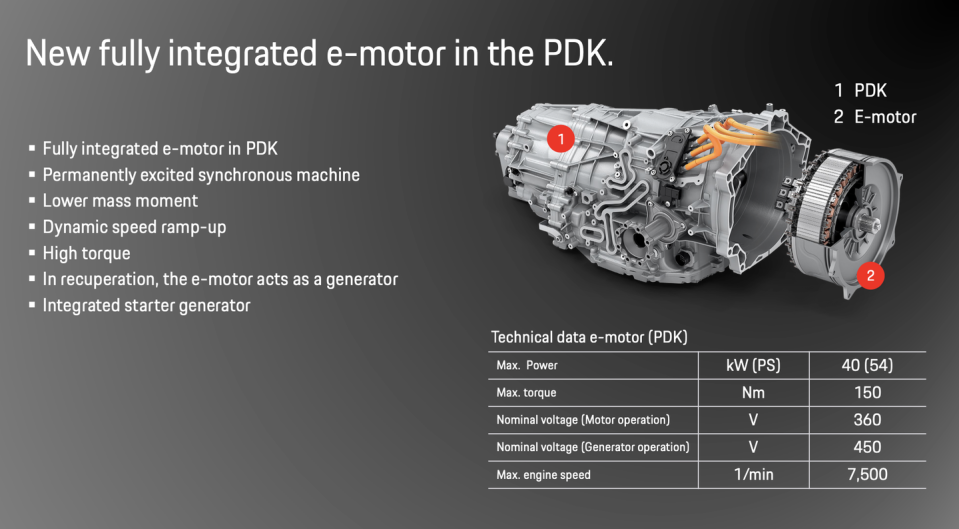
The motor is attached to the flat-six engine with no clutch in between the two, so there is no possibility of electric only operation. But the motor can deliver generous torque to supplement engine output at low revs. So even the short lag in pressure buildup of the electric turbocharger can be mitigated by the addition of electric drive torque. Coupled with the engine's maximums of 478 horsepower and 420 pound-feet, the total combined output rises to 532 horses at 7500 rpm and 449 pound-feet of torque from 1950 to 5000 rpm. Presumably, the hybrid operation also delivers some fuel efficiency benefits, but Porsche has made no such claims thus far.
Lithium-Ion Battery
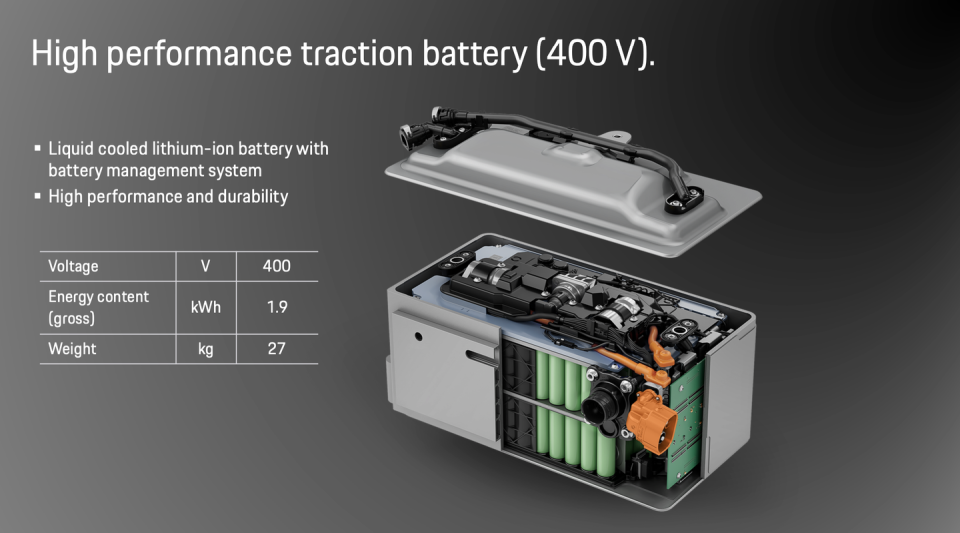
A lithium-ion battery uses 216 individual cells separated into two layers. Each layer of the so-called 21700 cells (21 mm in diameter by 70 mm in length) is wired in series, so 108 cells times 3.7 volts per cell equals 400 volts. The two layers are then wired in parallel, creating a battery with a maximum gross energy capacity of 1.9 kWh. It weighs about 60 pounds and is about the same size as a normal 911's lead-acid battery, and sits in about the same location just forward of the windshield, slightly to the right of center
Since a hybrid such as this GTS is constantly adding and withdrawing energy from this battery—much more often than a PHEV and vastly more often than a pure BEV—it's likely that little over half of this capacity, on the order of 1.1 kWh, is used to promote long battery life. The battery has its own liquid cooling system to keep its temperature below 108 degrees. A separate, small lithium-ion battery provides 12 volts for those systems that require it when the engine isn't running.
You Might Also Like

 Yahoo Autos
Yahoo Autos 